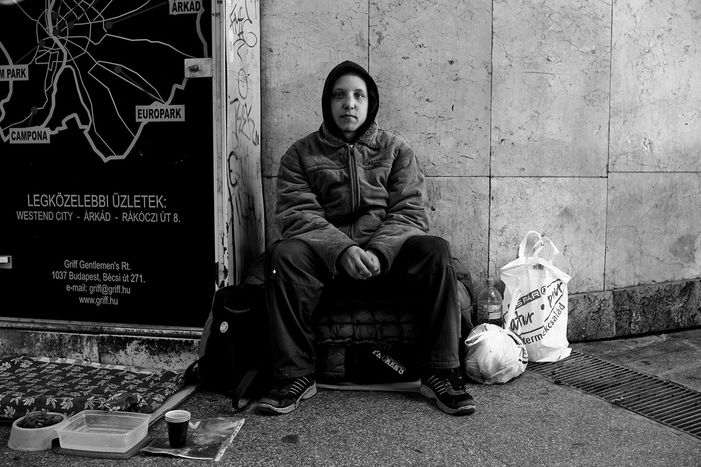
Budapest: poverty, Roma and the neighbourhoods (13 images)
Published on
Translation by:
 cafebabel.com
cafebabel.com
Criss-crossing the streets of Budapest, you catch on quite quickly that the Hungarian capital is an erudite mix of lights and shadows. Take Józsefváros, the inner city slum-like neighbourhood, which skims the posher areas where Porsches replace the old Skodas. As part of a monthly EU cities reporting project in Budapest, French photographer Damien Sueur aims at bringing light to the most sombre parts of the Hungarian capital

According to a Eurostat report published on 18 January 2010 for the 'European year for combatting poverty and social exclusion' (deep breath) - 37% of Hungarians are experiencing material poverty, making it the third poorest EU member state. After Malta, it has the highest unemployment rate, with only 55.4% of 15-64-year-olds holding down a job. This is far behind the European average of 64.8%. At the red lights here, a Hungarian is handing out the official magazine for the homeless, FedélNélkül. FN content ranges from narratives, anecdotes and poems written by the homeless themselves (Image: ©Damien Sueur/ damienrayuela.fr/)

'When it's cold, very few people open their windows. It's a nice day today, I hope it'll make it a good day,' he says. The Hungarian unemployment rate is waning whilst the European average is on the rise (Image: ©Damien Sueur/ damienrayuela.fr/)

In the castle district in Buda and other more touristy sites you'll hear the melodies of many Roma musicians (Image: ©Damien Sueur/ damienrayuela.fr/)

At Keleti pályaudvar and Nyugati pályaudvar (eastern and western railway stations respectively), life bustles in contrast with the immobility and stillness of the homeless people who sleep in the corners and the prostitutes who patrol around the edges (Image: ©Damien Sueur/ damienrayuela.fr/)

Csaba is head of projects at a big French group and works in the northern Hungarian city of Nyiregyhaza. There's only three or four Roma workers for every 1, 000 employees at his factory. 'The problem is that most employees need the Erettsegi (minimum university entry requirement, such as A-levels), which you get when you are eighteen. But the Roma often quit school when they are around fourteen years old.' The Roma community is often marginalised, especially without this access to the work market: 'I had a good Roma friend at school, a good guy, really good footballer, he could've played for the premier league. But I found out recently that he was sent to prison for theft and on drug trafficking charges' (Image: ©Damien Sueur/ damienrayuela.fr/)

Anna is a member of the Food Not Bombs collective, which is spread across 1, 000 cities globally. Two Sundays a month, they prepare and distribute vegan and vegetarian meals from food which has passed its shelf expiry date or has been thrown out during the markets. The sociology student is extremely active, and knows anti-poverty and exclusion associations well in Budapest. Menhely Alapítvány (the shelter foundation) and the red cross organise recycled clothes collections and provide a medical and psychological treatment for the homeless (Image: ©Damien Sueur/ damienrayuela.fr/)

Getting around on public transport is a golden enough opportunity to get a grasp of the social mix in Budapest, where there is very little immigration but boundless social inequality (Image: ©Damien Sueur/ damienrayuela.fr/)

The Budapest metro is a place for commuters as well as beggars. It transports those who rise early and come back late as well as those who do nothing much or, if they're 10% of the population, are actively looking for a job. The Hungarian central statistical office (HSCO) reports that the unemployment rate in Hungary rose to 9.7% of the active population between May and July 2009. In 2008, the unemployment rare was 7.5% during the same period (Image: ©Damien Sueur/ damienrayuela.fr/)

The 'Roma district' is also populated with sex workers, but it's not been abandoned by the town council. It's also called Józsefváros and could one day become a tourist quarter, according to another cafebabel correspondent (Image: ©Damien Sueur/ damienrayuela.fr/)

In District 8 you can see the biggest mix of Roma in Budapest, so prejudices in this neighbourhood pretty much keel on a different contingent (Image: ©Damien Sueur/ damienrayuela.fr/)

Memories of the recent past - Skodas and Ladas were the only cars on sale in the former soviet republic (Image: ©Damien Sueur/ damienrayuela.fr/)

The contrast with District 8 is more striking as you come out of the neighbourhood. As you edge closer to the Danube, the old Skodas and Ladas become a rarer sight for newer, fancier cars (Image: ©Damien Sueur/ damienrayuela.fr/)

As any post-crisis state, Hungary is heading for economic renewal. The Eurostat report has shown the more fragile side of Hungarian life though; these are the people who deserve the priority in upcoming months (Image: ©Damien Sueur/ damienrayuela.fr/)
Translated from Budapest : lendemain de crise


